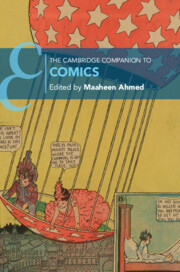Book contents
- The Cambridge Companion to Comics
- The Cambridge Companion to Comics
- Copyright page
- Contents
- Figures
- Contributors
- Acknowledgments
- Chronology
- Introduction
- Part I Forms
- Chapter 1 Comics Drawing
- Chapter 2 Comics, Media Culture, and Seriality
- Chapter 3 Comics and Graphic Novels
- Chapter 4 Manga
- Chapter 5 Digital Comics
- Part II Readings
- Part III Uses
- Further Reading
- Index
- Cambridge Companions To …
- References
Chapter 3 - Comics and Graphic Novels
from Part I - Forms
Published online by Cambridge University Press: 17 August 2023
- The Cambridge Companion to Comics
- The Cambridge Companion to Comics
- Copyright page
- Contents
- Figures
- Contributors
- Acknowledgments
- Chronology
- Introduction
- Part I Forms
- Chapter 1 Comics Drawing
- Chapter 2 Comics, Media Culture, and Seriality
- Chapter 3 Comics and Graphic Novels
- Chapter 4 Manga
- Chapter 5 Digital Comics
- Part II Readings
- Part III Uses
- Further Reading
- Index
- Cambridge Companions To …
- References
Summary
What makes a comic a graphic novel? Is it having a long, complete narrative? Being published as a book? Having a complex storytelling technique that leads to literary awards and critical acclaim? All these criteria have been deployed at some time or another to define the graphic novel, and they recur throughout this chapter as we follow a history of the ways in which comics have been hailed as novels since the mid-nineteenth century. With an emphasis on the United States, key moments are considered such as the woodcut novels of the 1920s and 1930s, the start of the direct market in the 1970s, the first graphic novel boom of the 1980s, and the popularity of graphic novels in the twenty-first century. Notable texts, creators, and publishers are discussed, such as Art Spiegelman’s Maus and Raw Books & Graphics, and we see the changing economic contexts out of which graphic novels have emerged. This chapter ends by outlining how the Internet has transformed the production, distribution, and selling of graphic novels, with contemporary creators unshackled from the idea that a graphic novel has to be a book.
- Type
- Chapter
- Information
- The Cambridge Companion to Comics , pp. 63 - 81Publisher: Cambridge University PressPrint publication year: 2023



